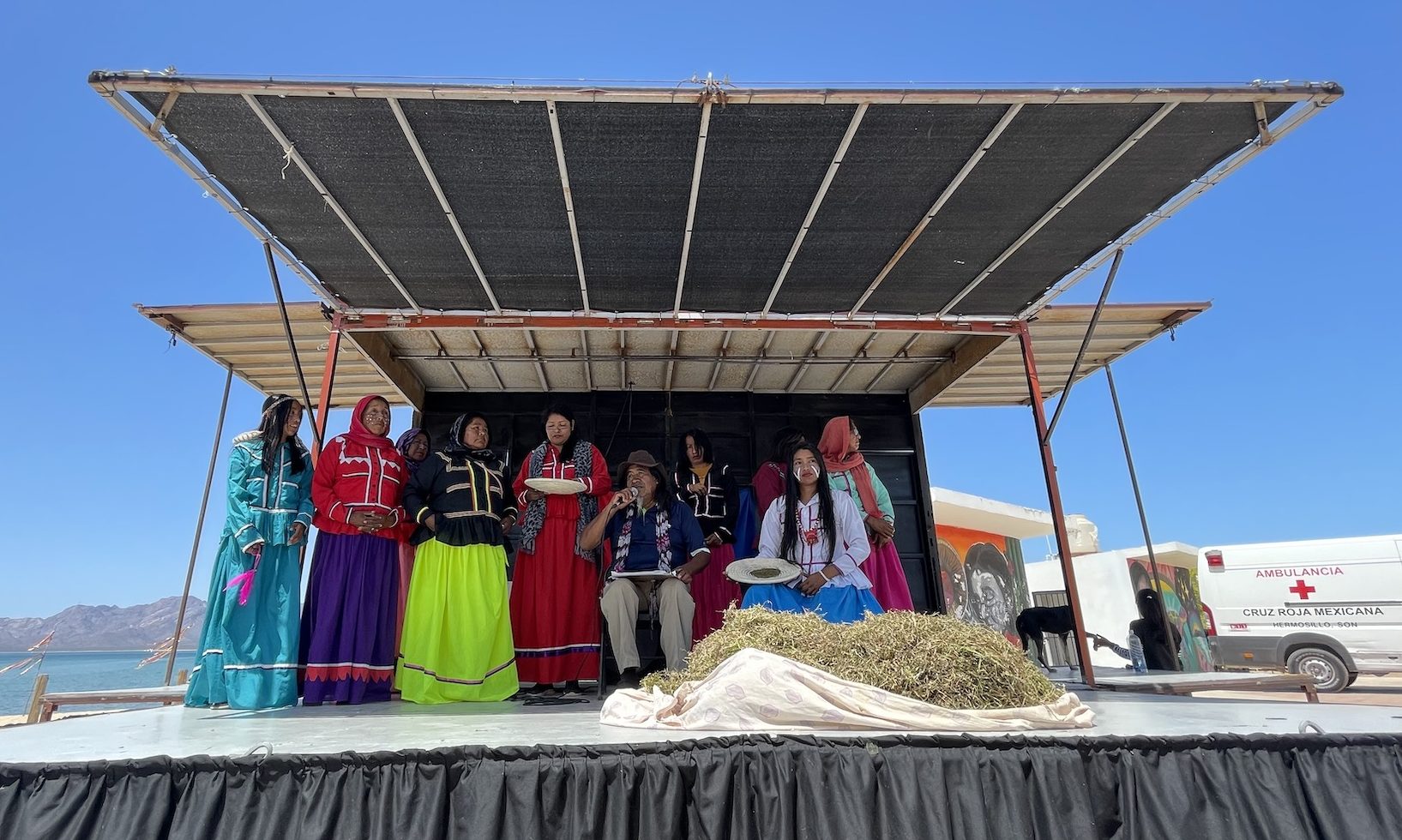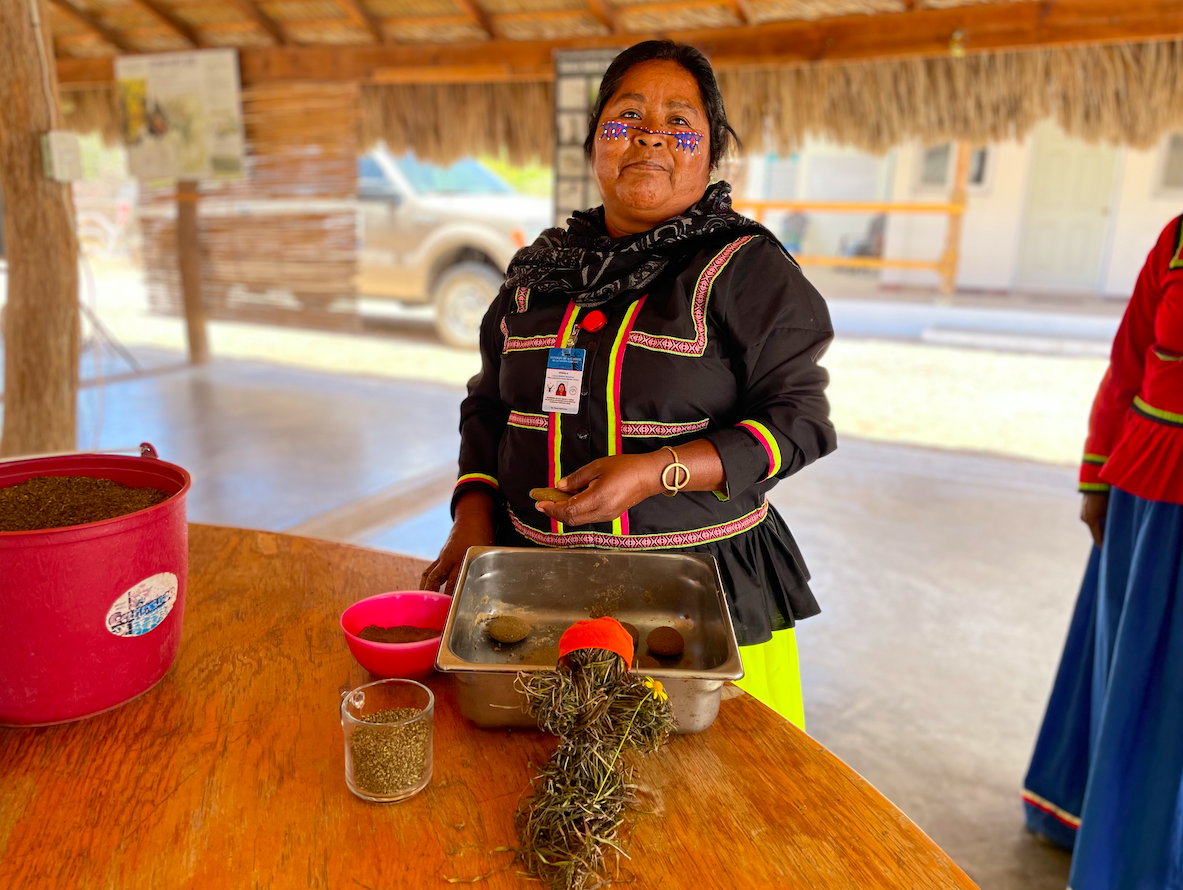- The Indigenous Comcaac community of northwestern Mexico is working to preserve eelgrass and promote the renaissance of the grain they obtain from it.
- Known as xnois, this grain from the Zostera marina seagrass was once a vital ingredient in Comcaac food, and was sustainably harvested without harming seagrass meadows.
- Current generations of Comcaac hope to revive the ancient traditions while preserving the seagrass meadows off the coast of their territory.
- Through a recent cultural festival, they showcase the versatility of xnois in both traditional and modern cuisine, from tortillas to energy bars.
PUNTA CHUECA, Mexico — Legend has it that, many thousands of years ago, a messenger arrived in the Comcaac land on board a strange boat after sailing on the waters of the Infiernillo Channel. The people were said to have welcomed the boat with the bill of a duck and the tail of another bird.
“He was the messenger of a great spirit,” says René Montaño, a Comcaac linguist. “He told our ancestors that he spread xnois seeds all along the channel so that the grass would grow for the community’s use. He gave us permission to collect it and take care of it.”
Montaño is addressing the entire community at a cultural festival in the Comcaac territory in what is today northwestern Mexico. He talks about how their ancestors learned that xnois (Zostera marina), a type of seagrass also known as eelgrass, could feed their people.

“Zostera marina is paramount for us,” Montaño says. “There are other parts of the world where it barely exists, but here, in this channel, there’s plenty. The messenger showed people how to harvest it, what parts shouldn’t be touched so that it can regrow.”
From that moment, Comcaac warriors and fishers learned that it was a food that would give them the necessary strength to survive long days at sea, and the different ways it could be prepared were passed down from generation to generation. In the past few decades, this knowledge has been largely neglected. Today, the Comcaac people are breathing new life into it.

Seagrass and blue carbon
Comcaac environmentalists Alberto Mellado and Erika Barnett, together with ethnobotanist Gary Paul Nabhan and cultural ecologist Laura Monti — both of whom are affiliated with the NGO Borderlands Restoration Network and have worked with the Comcaac people for more than 40 years — have been developing a study since 2020 that focuses on the territory’s “blue carbon” potential. That’s the carbon sink represented by coastal and marine ecosystems, like mangrove forests and seagrass meadows.
Unlike with tropical rainforests, which are studied extensively, estimates about carbon storage in these ecosystems are scarce. The team is working on seafloor sampling to learn about the carbon storage and complete a study that offers sufficient data to facilitate access to payment for ecosystem service (PES) programs that can benefit the Comcaac people.

The Infiernillo Channel, located between the Sonora coast and Tiburón Island — the largest island in Mexico and a sacred site for the Comcaac people — is a Ramsar site, meaning it’s a wetland of key global importance. It features seagrass meadows, mangrove estuaries, and small patches of coral reefs where various marine species feed. These species are the basis of the commercial and artisanal fisheries in the area. The channel is also home to 81 species of invertebrates endemic to the Gulf of California, and various threatened species, like totoabas (Totoaba macdonaldi) and sea turtles.

“The Ramsar protected area inside the Infiernillo Channel is 30,000 hectares [74,000 acres] and seagrass covers 9,725 hectares [24,000 acres], more than in any other place in the Mexican Pacific,” Nabhan told Mongabay Latam in December 2021. He cited a 1999 study by Alf Meling, a researcher in the University of Sonora, that found the channel sequesters approximately 46,000 metric tons of carbon dioxide per year.
“That is more than anywhere else in the Gulf of California,” Nabhan said. “Marine plants sequester more carbon per hectare than most forests and rainforests on land.”
That’s why it’s important to protect the area and enlarge not only the seagrass meadows but also the mangrove forests. Some residents have established a local nursery where they grow three different species of mangrove trees that they then plant in places where they didn’t exist before.
The rebirth of xnois
In early 2022, as part of this initiative, the team created an event that brought together chefs and biologists from Sonora, the U.S. and Spain who were interested in the culinary uses of xnois and in the conservation of seagrass. There, the Comcaac cooks shared their knowledge about the ancestral ways of preparing xnois: ground by hand to make flour for tortillas or tostadas, or as a drink made with warm water combined with honey or oil (the latter used to be extracted from loggerhead turtles, Caretta caretta). Newer ways of preparing xnois were also on show, such as in energy bars, hotcakes, and bread in combination with wheat flour.

The use of xnois was first documented in 1645, when Spanish missionaries arrived in the Comcaac territory. A 1973 study published in Science showed it had high nutritional value when compared to other grains like corn or wheat.
Today, it’s Comcaac natives like Laura Molina working to promote the benefits of xnois to the rest of the world. In a workshop at the Sonora headquarters of Prescott College, an educational institution from Arizona focused on social and environmental studies, she flattens small dough balls into tortillas and toasts them over a fire. She says the first time she heard about this ancestral food was from her grandmother. Years later, she asked her mother to teach her how to prepare it.

“Thanks to her, I learned to prepare the grains, because I asked those older than me, but no one gave me any explanation,” Molina says. “Then, very nervously, I said, ‘I’m going to do it, I’m going to try to do what my mother taught me.’”
The recipe for any xnois dish, as she learned it, starts with a trip to the sea to collect eelgrass that has detached from the floor and been washed ashore by the waves; it’s important that the seagrass not be pulled directly from the seafloor. The eelgrass is then laid out on a threshing mat to dry under the sun for several days, turned periodically so that all sides dry evenly. They then pound the dried eelgrass with a heavy wooden stick and cut incisions by hand so that the seeds drop to the bottom of the threshing mat and the hollowed-out stems are blown away with the wind.

For the Comcaac cultural festival, preparing the xnois was a long process that yielded barely a bucket of grain — just enough to cook samples of everything they’d learned and share it with the attendees. “The elders won’t always be with us, that’s why we need to take advantage and ask about our customs, our traditional food and medicinal plants as well,” Molina says.
Erika Barnett says her great-grandparents were probably the last ones in the family to harvest eelgrass for the seeds. She says the fact that her father, now 76, can once again eat food prepared with xnois represents a great success. “The last time he’d eaten it, he was 7 years old,” she says. “Most young people have never tasted it, so this effort is really rescuing our culture.”

Global interest in seagrass and xnois
Juan Martín is a biologist with the restaurant Aponiente, managed by Spanish chef Ángel León who is renowned for cooking with ingredients sourced from the sea. He says they started considering eelgrass seeds as a food source in 2018 after León read the 1973 study in Science. This inspired them to study the seeds and realize that they indeed had surprising nutritional value: besides being gluten-free, xnois has high levels of protein, fiber and healthy fats.
“You can preserve nature with your fork, and Comcaac people have been doing it for thousands of years,” Martín says. He traveled to Sonora for the Comcaac cultural festival for the second time, this time with a colleague, Greg Martínez, also a biologist and chef.

“Food can help us to connect with these environmental topics. Health, love … everything,” Martínez says. “This plant has inspired a lot of people in the world: there are projects to create these connections with Japan, Australia and the United Kingdom because this plant is endangered in other regions and it’s one of the most important ones for climate change and carbon sequestration. And no one had thought of it as food before, but the Comcaac people give us another perspective.”
The Comcaac people consider it essential to bring xnois back out of obscurity. During the cultural festival, children and their mothers observe how to prepare the grain to transform it into different products.
“The guys and my colleagues didn’t know how to prepare xnois, but I’m happy because we’re teaching them and the kids and adults who want to learn,” Molina says. “This is thanks to our ancestors. We didn’t do any experiments, they opened the path that led us here.”

Banner image: Erika Barnett pounds eelgrass while her sister, Romelia, cuts incisions by hand to extract the seeds. Image by Astrid Arellano for Mongabay.
This story was reported by Mongabay’s Latam team and first published here on our Latam site on June 6, 2022.
Citations:
Felger, R., & Moser, M. B. (1973). Eelgrass (Zostera marina L.) in the Gulf of California: Discovery of its nutritional value by the Seri Indians. Science, 181(4097), 355-356. doi:10.1126/science.181.4097.355
Related audio from Mongabay’s podcast: Ethnobotanist Gary Nabhan discusses this ancestral food of the Comcaac people and why eelgrass is making a big comeback as a sustainable source of food for the community and gaining international attention in the process. Listen here:
Podcast: Indigenous, ingenious and sustainable aquaculture from the distant past to today
